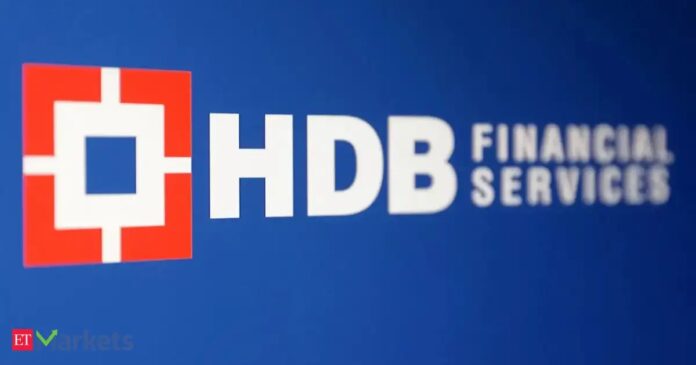The Rs 12,500 Crore IPO of HDB Financial Services: A Tale of Diverging Market Sentiment
The recent initial public offering (IPO) of HDB Financial Services, valued at Rs 12,500 crore, has unveiled a striking divide in market sentiment. While institutional investors demonstrated overwhelming enthusiasm with a staggering 55.47 times subscription rate, retail investors remained cautious, barely surpassing a 1.4 times subscription. This dichotomy highlights contrasting perspectives on the future of India’s credit economy, with institutional players betting on long-term growth while retail investors exhibit skepticism.
Big Money Backs Big Bets
Institutional investors are known for their long-term investment strategies, and their robust participation in HDB Financial’s IPO reflects this approach. Sunny Agrawal, Head of Fundamental Equity Research at SBI Securities, noted that the strong backing from institutions is largely due to HDB’s solid parentage and scalable business model. The IPO attracted bids worth Rs 2.08 lakh crore, with institutional bids alone amounting to Rs 1.31 lakh crore. This level of demand places HDB Financial among the ranks of IPO giants like Bajaj Housing Finance and Waaree Energies.
Tarun Singh, MD and Founder of Highbrow Securities, emphasized HDB’s structural advantages as a diversified, RBI upper-layer NBFC, bolstered by HDFC Bank’s extensive distribution network. The 55-times subscription from Qualified Institutional Buyers (QIBs) underscores confidence in HDB’s ability to thrive in India’s evolving lending landscape, particularly in Tier 2 to Tier 4 cities.
The Retail Pullback
In stark contrast, retail investor interest was markedly subdued. Agrawal pointed out that many retail investors approach IPOs with a focus on immediate listing gains. Given the tepid grey market premiums (GMPs), their response was understandably muted. Although the GMP showed slight improvement, climbing from Rs 67 to Rs 73, suggesting a potential 9.9% listing gain, retail appetite remained lackluster.
The large size of the IPO and a history of underwhelming post-listing performances in similar issues likely contributed to retail investors adopting a “wait and watch” stance. Singh echoed this sentiment, noting that retail investors are wary of NBFC valuations amid ongoing margin pressures and recent IPO disappointments.
A Strategic Play, Not a Bargain Hunt
Analysts agree that institutional investors are not chasing a bargain with HDB’s IPO. Singh remarked, “Nobody’s buying this IPO for its bargain valuation. At 3.5x book, you’re paying full freight for the HDFC pedigree.” Instead, institutions are acquiring a strategic position in India’s financial formalization. HDB’s extensive network of 1,700 branches positions it as a potential target in the upcoming consolidation wave among NBFCs.
Regulatory tailwinds further bolster this institutional play. Singh highlighted that institutions are strategically positioning themselves to benefit from the RBI’s push for the institutionalization of shadow banking. With a capital adequacy ratio of 16.8%, HDB is well-equipped to consolidate market share as smaller NBFCs face regulatory pressures.
Valuation, Fundamentals, and Future Outlook
According to Mirae Asset Capital Markets, HDB’s fundamentals remain strong, with a projected return on assets (ROA) of 2.2% and return on equity (ROE) of 14.7% by FY25. However, they caution that the IPO is “fully priced” based on these fundamentals. Highbrow’s Singh added that while HDB trades at a discount to Bajaj Finance, it offers better diversification, particularly if it can leverage HDFC Bank’s network effectively.
The company’s omni-channel, semi-urban-focused distribution model is a significant draw for institutional investors. Singh noted, “Institutions aren’t just buying an NBFC; they’re acquiring a strategic beachhead in India’s formalizing credit economy.”
A Bellwether for Future NBFC Listings?
The strong institutional response to HDB’s IPO may set a precedent for upcoming NBFC and financial services IPOs. Singh suggested that this validates the RBI’s push to list large NBFCs, encouraging peers to follow suit. However, he emphasized that issuers must justify their valuations with detailed asset-quality disclosures to attract retail investors.
Mirae Asset also pointed out that HDB’s “AAA credit rating” helps it manage borrowing costs and supports its margin profile, making it a fundamentally attractive business despite not being undervalued.
The Road Ahead: Listing Gains
Analysts anticipate a potential listing gain of 10–15%, which could shift retail sentiment positively. Singh noted that retail participation could revive if market conditions stabilize and IPO pricing becomes more appealing.
For now, the IPO of HDB Financial Services has illuminated a clear market divide: institutional investors are focused on long-term structural gains, while retail investors remain cautious, seeking trust and timing in India’s crowded public markets. As the landscape evolves, the contrasting approaches of these two investor groups will continue to shape the future of India’s financial sector.

